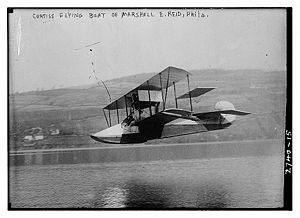Curtiss Model F Video - Picture

|
|
Curtiss Model F
Models E and F

Role: Utility flying boat
Manufacturer: Curtiss Aeroplane and Motor Company
Designed by: Glenn Curtiss
First flight: 12 January 1912
Primary users: United States Navy
Russian Navy
Italian Navy
Number built: over 150
The Curtiss Models F made up a family of early flying boats developed in the United States in the years leading up to World War I. Widely produced, Model Fs saw service with the United States Navy under the designations C-2 through C-5, later reclassified to AB-2 through AB-5. Several examples were exported to Russia, and the type was built under licence in Italy.

Picture - Marshall Earle Reid at Keuka Lake in his Curtiss seaplane circa 1912
Design and development
In configuration, these were biplane flying boats powered by a single engine mounted amongst the interplane struts and driving a pusher propeller. The pilot and a single passenger sat side-by-side in an open cockpit. The wing cellule was derived from the Model E landplane and was of two-bay, unstaggered, equal-span construction with large ailerons mounted on the interplane struts and extending past the span of the wings themselves. The earliest examples of this design were built and sold by Curtiss in 1912 without any designation applied to them; the Model F name only coming into use the following year. Confusingly, Curtiss also used the designation Model E to refer to some early machines in this family, although these were quite distinct from Curtiss landplanes that bore this same designation and all but identical to the Model Fs.

Picture - Gustave Maurice Heckscher in his Curtiss seaplane at 60 miles per hour circa 1912
Model Fs built from 1918 featured a revised, unequal-span wing that incorporated the ailerons into the upper wing and sponsons on the sides of the hull to improve the aircraft's handling in water. These were known as the Model MF (for Modernised-F), and years later as the Seagull in the post-war civil market.
Operational history
The US Navy initially purchased four of these aircraft in addition to the Freak Boat (C-1/AB-1) that it had already obtained and which was retrofitted to approximately the same design as the others. One of these, the C-2 became the first aircraft to fly under automatic control on 30 August 1913 when fitted with a gyroscopic stabiliser designed by Elmer Sperry. The same aircraft (by now redesignated AB-2) then became the first aircraft to be launched by catapult from a warship while underway when it took off from USS North Carolina on 5 November 1915. Her sister, AB-3, became the first US heavier-than-air aircraft to see military action when launched from USS Birmingham on 25 April 1914 on a scouting mission over Veracruz during the United States Occupation of Veracruz.
The US Navy bought another eight aircraft before the end of 1916, but orders in quantity only came following the type's selection as the Navy's standard flying-boat trainer in April 1917. An initial batch of 144 of the basic F model were ordered, followed by 22 MFs in 1918. Another 80 MFs were produced under license by the Naval Aircraft Factory. A small number of Model Es and Fs were also purchased by the US Army.
The Russian Navy purchased two batches of Model Fs in 1913-14 and operated them as part of the Black Sea and Baltic Sea fleets until replaced by the Model K shortly thereafter. In Italy, the Curtiss representative Enea Bossi secured rights for local licence-production of the Type F by the Zari brothers, who built eight examples at their workshop in Bovisia, near Milan. The first of these was demonstrated to the Italian Navy on Lake Como on 22 September 1914.
Variants
Model E
Designation sometimes applied to certain early members of this family.
Sperry-Curtiss E
Amphibious version of Model E for Lawrence Sperry.
School Machine
Trainer with nose boarding ramp.
Sport Boat
Three seat deluxe version.
Reid Hydroaeroplane
Custom version for Marshall Reid with shoulder-yoke aileron controls.
Sperry-Curtiss E
Amphibious version of Model E for Lawrence Sperry.
School Machine
Trainer with nose boarding ramp.
Sport Boat
Three seat deluxe version.
Reid Hydroaeroplane
Custom version for Marshall Reid with shoulder-yoke aileron controls.
Model F
Standard production model from 1912 onwards, received this designation 1914.
Model MF
Modernised version of 1914, production standard from 1918 onwards.
Model MF
Modernised version of 1914, production standard from 1918 onwards.
Seagull
Post-war civil version of MF with two additional seats.
Seagull
Post-war civil version of MF with two additional seats.
Seagull
Post-war civil version of MF with two additional seats.
Judson Triplane
Enlarged custom triplane version.
McCormick Flying Boat
Enlarged, five-seat custom version for Harold McCormick.
Judson Triplane
Enlarged custom triplane version.
McCormick Flying Boat
Enlarged, five-seat custom version for Harold McCormick.
Model FL
Model F fitted with wings from Curtiss Model L. Single example, also designated Model 7 built 1917.
Operators
Italy
Italian Navy
Russian Empire
Russian Navy received two batches of Model Fs in 1913-14.
United States
United States Navy
United States Army
Specifications (1917 Model F)
Data from Curtiss Aircraft 1907-1947
General characteristics
Crew: Two
Length: 27 ft 9¾ in (8.47 m)
Wingspan: 45 ft 1⅜ in (13.75 m)
Height: 11 ft 2â…ž in (3.42 m)
Wing area: 387 ft² (36.0 m²)
Empty weight: 1,860 lb (844 kg)
Gross weight: 2,460 lb (1,116 kg)
Powerplant: 1 x— Curtiss OXX-3 V-8, 100 hp (75 kW)
Performance
Maximum speed: 69 mph (111 km/h)
Endurance: 5 hours 30 min
Service ceiling: 4,500 ft (1,370 m)
Rate of climb: 230 ft/min (1.2 m/s)
Bowers, Peter M. (1979). Curtiss Aircraft 1907-1947. London: Putnam. ISBN 0 370 10029 8.
Taylor, Michael J. H. (1989). Jane's Encyclopedia of Aviation. London: Studio Editions. pp. 193, 278.
The Curtiss Flyleaf. Hammondsport, New York: Glenn H. Curtiss Museum of Local History. 1987.
World Aircraft Information Files. London: Bright Star Publishing. pp. File 891 Sheet 43.
Curtiss Model F Pictures
More aircraft.
Source: WikiPedia